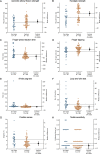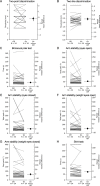Quantifying upper limb motor impairment in people with Parkinson's disease: a physiological profiling approach
- PMID: 33604177
- PMCID: PMC7869669
- DOI: 10.7717/peerj.10735
Quantifying upper limb motor impairment in people with Parkinson's disease: a physiological profiling approach
Abstract
Background: Upper limb motor impairments, such as slowness of movement and difficulties executing sequential tasks, are common in people with Parkinson's disease (PD).
Objective: To evaluate the validity of the upper limb Physiological Profile Assessment (PPA) as a standard clinical assessment battery in people with PD, by determining whether the tests, which encompass muscle strength, dexterity, arm stability, position sense, skin sensation and bimanual coordination can (a) distinguish people with PD from healthy controls, (b) detect differences in upper limb test domains between "off" and "on" anti-Parkinson medication states and (c) correlate with a validated measure of upper limb function.
Methods: Thirty-four participants with PD and 68 healthy controls completed the upper limb PPA tests within a single session.
Results: People with PD exhibited impaired performance across most test domains. Based on validity, reliability and feasibility, six tests (handgrip strength, finger-press reaction time, 9-hole peg test, bimanual pole test, arm stability, and shirt buttoning) were identified as key tests for the assessment of upper limb function in people with PD.
Conclusions: The upper limb PPA provides a valid, quick and simple means of quantifying specific upper limb impairments in people with PD. These findings indicate clinical assessments should prioritise tests of muscle strength, unilateral movement and dexterity, bimanual coordination, arm stability and functional tasks in people with PD as these domains are the most commonly and significantly impaired.
Keywords: Hypokinesia; Levodopa; Movement disorders; Parkinson disease; Tremor; Upper extremity.
©2021 Ingram et al.
Conflict of interest statement
The authors declare there are no competing interests.
Figures








References
-
- Aragon A, Ramaswamy B, Ferguson C. The professional’s guide to Parkinson’s disease. Parkinson’s Disease Society of the United Kingdom; London: 2007.
-
- Beaton DE, Davis AM, Hudak P, McConnell S. The DASH (Disabilities of the Arm, Shoulder and Hand) outcome measure: what do we know about it now? British Journal of Hand Therapy. 2001;6:109–118. doi: 10.1177/175899830100600401. - DOI
LinkOut - more resources
Full Text Sources
Other Literature Sources

